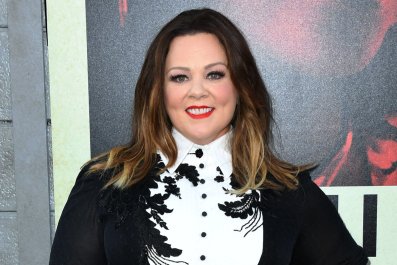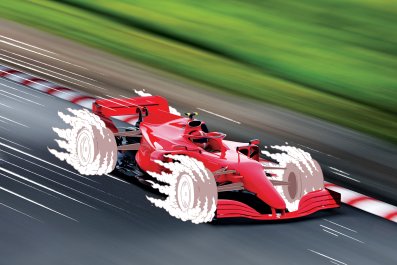Dutch driver Max Verstappen may have claimed victory at the Miami Grand Prix on May 7, but it was Formula 1 president and CEO Stefano Domenicali who was the real winner. The second running of the race was the first of three grand prix in America this racing season—the most held on U.S. soil in nearly 40 years—in a resurgence led by the Italian executive and the series' Colorado-based owner, Liberty Media.
Through clever marketing via social media and the hit Netflix series Drive to Survive, plus enough youth-friendly "woke" ideology to ruffle the feathers of the Miami Grand Prix's host state governor, Ron DeSantis, Formula 1 is capturing the imagination of a new generation of American fans. With a seemingly glamorous, celeb-filled international jet set vibe and the buckets of cash that come with it—reigning champion Verstappen is said to be raking in $55 million to drive his Red Bull Honda this season—it is not hard to see how Formula 1 has turned more than a few young heads in the past few years.
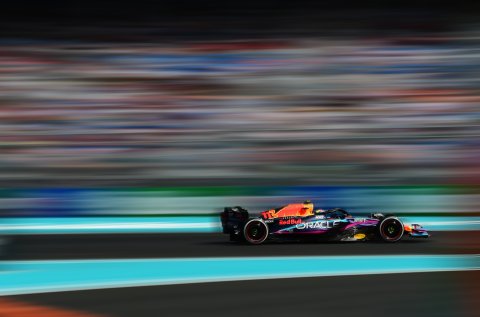
"This is an incredible opportunity to make sure that the new fans watching for the first time are captured by us," Domenicali told Newsweek before the Miami race. "Explaining the sporting excitement that is on the track, explaining the incredible experience that we want to give to the fans that are attending the races, and explaining the passion and the technology that is behind the scene of Formula 1 and making sure that we give to our new American audience all the elements for them to choose. We want to make sure that they have everything [so] they're going to choose Formula 1, for bigger growth for us in this incredible country."
The European-dominated racing series has, for now, headed back to the continent, where the bulk of the summer races are held, starting with the Monaco Grand Prix in Monte Carlo this past weekend and the Spanish Grand Prix in Barcelona coming up on Sunday. F1's new stateside focus, however, hasn't been missed by other American heavyweights in motor sport.
Gene Haas, founder of toolmaker Haas Automation and co-owner of Stewart-Haas Racing, which competes in NASCAR, debuted his eponymous Formula 1 team in 2016. Meanwhile, Ford is set to supply engines to the Red Bull team starting in 2026, and Andretti Global is teaming up with Cadillac to potentially join the championship in 2025 (pending approval by F1). There is even an American F1 driver, 22-year-old Logan Sargeant, in the series for the first time since 2015.
"It is so good to be home," the Florida native told Newsweek, before the Miami race. "I'm definitely proud and privileged to have the opportunity to represent America. I've done the full loop of starting racing here in Miami and coming back to race F1 here is pretty special."
Not perhaps since 1978, when Mario Andretti became only the second American (after Phil Hill in 1961) to win a world championship, has Formula 1 enjoyed such popularity in the U.S. ESPN saw record viewership in 2022, with an average of 1.2 million viewers a race across ESPN, ESPN2 and ABC, a 28 percent rise over the previous record of 949,000 average viewers set in 2021. The 2022 season was also the first in U.S. television history to average 1 million or more viewers per race.
Some 400,000 fans headed to Austin for the United States Grand Prix last year—the most of any race on the F1 calendar—while Formula 1 said that in 2021 followers across Facebook, Twitter, Instagram, YouTube, TikTok, Snapchat, Twitch and Chinese social platforms increased to 49.1 million. By 2022, that had grown again by another 23 percent. Over the past four years, F1 says it has been the fastest growing global sport league in terms of social media followers. And it's now a gender-diverse group too: Around 40 percent of Formula 1 fans are female, up from just 8 percent when Liberty Media bought the racing series in 2017 in a $4.4 billion deal.
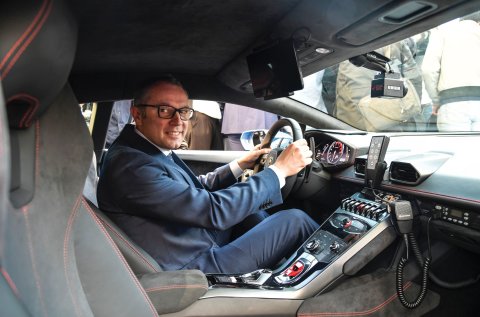
All of these fans helped Formula 1 earn $2.6 billion in total revenue in 2022, up from $2.1 billion the previous year. Operating income increased 333 percent, from $40 million to $173 million over the same period. Surging fan interest and revenues have seen the total value of the business soar to nearly $17 billion.
Despite this success, Domenicali is not done yet. In an exclusive interview with Newsweek, he talked about Formula 1's drive to grow the championship even further in America and beyond, how he is improving diversity and getting more women involved in the sport, how technology will play a crucial role for F1 to achieve its pledge of carbon-neutrality by 2030, and how he hopes a new Hollywood film starring Brad Pitt and produced by champion driver Lewis Hamilton will capture all of the glitz, glamor and thrills of the open-wheel racing series.
'My Love Has Always Been with Cars and Motor Sport'
"I'm in Miami," said 58-year-old Domenicali, all smiles on a call from the Sunshine State before the Grand Prix. He speaks with the excitement of a schoolboy and at the speed of an F1 car going full pelt as he describes his enthusiasm for motor sport. He was born the son of a banker in Imola, home of the Emilia-Romagna Grand Prix, which was called off in May due to heavy storms and flooding in the region that claimed at least 13 lives.

The region is the heartland of Italian motor racing. It is home to Ferrari, where in 2008, as team principal, Domenicali won a Constructors' Championship, F1's top prize for race teams, and to Lamborghini, where he was chief executive from 2016 to 2021, when he left to run Formula 1. But the CEO's passion for racing started much earlier than that.
"My love has been always with cars and motor sport," said the bespectacled F1 boss, who counts skiing and aviation as his hobbies (he served in the air force when he was younger). "I was looking at racing when I was a child. [In] high school, I was going like a lot of students, helping the promoter, to be there at all the races. Then, after university [in Emilia-Romagna's capital, Bologna], I sent my [resume] to a lot of companies and I started that journey when I was 26 formally with Ferrari."
He insists his successful career in the top echelon of motor sport is one based on hard work that can be replicated by equally capable and industrious individuals. The married father of two said: "I feel very proud but very privileged. I come from a very normal family, I went to public school, and I'm here....So, that shows that with commitment, with the passion, dedication, competence, there's no barrier."
For alongside words such as speed, excitement, entertainment and adrenaline, which you would expect to hear from the boss of a high-octane sport, during his talk with Newsweek Domenicali often mentioned other terms that, for some, may be more unexpected: diversity, inclusion, sustainability and responsibility.
'We Take Sustainability Very Seriously'
Domenicali is deeply committed to the sport's Net Zero 2030 pledge, with plans to cut F1's carbon footprint by a minimum of 50 percent by the end of the decade. To reach this target, F1 will focus primarily on reducing the amount of equipment and people the group and all 10 teams move around the world. Travel and logistics created nearly 73 percent of Formula 1's overall carbon footprint of 256,551 tons of CO2 in 2018, with facilities and factories creating nearly 20 percent. Just over 7 percent came from event operations, F1 said in a report. By changes it had made in its working practices, which include using renewable energy at its offices and, where possible, at race venues, F1 said by 2021 it had already reduced its overall carbon output by 17 percent.
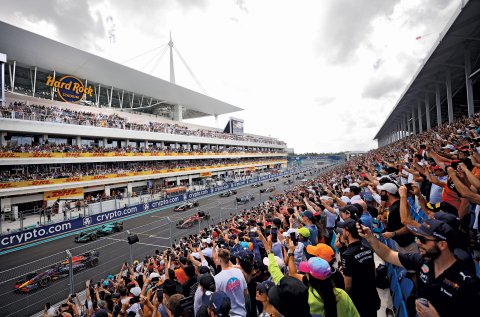
Domenicali says the goal will also be achieved with the help of the racing series' business partners, which include Saudi oil giant Aramco, by introducing e-fuels to help power the electric hybrid engines that the cars already use now, even though race car emissions make up less than 1 percent of the sport's carbon footprint.
He says e-fuels, made from combining hydrogen and carbon dioxide in an industrial process to create a synthetic fuel that produces zero net emissions, will not only help Formula 1 lower its carbon output but the technology can also be scaled for use in the aviation industry and with shipping, as well as in consumer cars and trucks. Many improvements in hybrid engines in personal vehicles have been advanced by technologies developed in Formula 1, but so far e-fuels have proven too expensive for mass commercial use.
Domenicali said: "We take sustainability very seriously. We have already decided to go hybrid with sustainable fuel in 2026. And we are pushing very hard to make sure that we are carbon neutral in 2030."
"It's a big job," he added, which is "the reason why we need everyone to embrace our strategy, that the strategy is right, and we need to deploy it with the help of every single component of our ecosystem. I think that the speed of Formula 1 can accelerate this technology to be much more effective."
Formula 1 is not the only sport to do this. The NBA has pledged to halve its carbon emissions by 2030 and to be net zero by 2040. Like F1, Commissioner Adam Silver has said much of this will be achieved by changing the schedule to reduce travel.
To get to net zero by 2030, Domenicali says that "carbon credit is part of the complete strategy, for sure"—which is where some critics say the plan falls down.
Carbon credits are purchased by companies (or governments or individuals) to offset emissions by supporting projects, such as tree planting and mangrove restoration, that remove carbon from the atmosphere. There have been questions surrounding the efficacy of some such projects, but Formula 1's head of ESG, Ellen Jones, insisted the sport's primary goal now is to reduce its own emissions. However, Jones added: "We do realize as we get closer to 2030 offsets will have to be considered for what is that remaining balance of unavoidable emissions."
When asked if Formula 1 can really be carbon neutral by 2030, Ursula Bittner, economic expert at Greenpeace, told Newsweek: "If they're using offsets, definitely not." She added: "Our view is that offsets are counterproductive because it basically gives the option to not really reduce [emissions]."
Formula 1's accounting also does not appear to include the carbon created by fans attending events. If just 10 percent of the estimated 5 million fans who went to watch Formula 1 races in 2022 traveled 60 miles on their journeys, Bittner said, that alone would create an additional 10,000 tons of carbon, the equivalent of running 6,000 family cars for a year.
Bittner said Formula 1 "needs to change to electric cars", a plan that Domenicali has dismissed. However, Bittner wasn't wholly dismissive of F1's plan: "If they take [their carbon pledge] seriously, they could be like a perfect role model, not only for other sports but also for people and also having investments in science."
'We Want to Have a More Diverse Culture'
As well as trying to go green, Formula 1 is attempting to tackle diversity head-on through its F1 Academy, a racing series that is literally putting women in the driving seat. Only two women, Italians Maria Teresa de Filippis and Lella Lombardi, have ever qualified to race in Formula 1.

Domenicali said: "This year we have the F1 Academy to make sure we can have some girls be attracted [to] our sport. That's showing with facts, money and investment, how we really do care about the diversity in our sport, not only in terms of drivers, but also we want to have a more diverse culture and diverse people in our ecosystem—engineers, mechanics, technicians, marshals—everyone."
The F1 Academy is a 21-race series featuring 15 female drivers on five teams with the aim of developing young women to higher levels of competition. The Academy teams are run by current teams in Formula 2 and 3. These are open-wheeled racing series with cars that have less power and cheaper parts than in F1, allowing drivers to gain experience in the hope of one day reaching the big time. Domenicali has suggested it may take five years before we see a female driver make it to Formula 1.
F1 has also extended a scholarship program, started in 2020 with a $1 million personal donation by Domenicali's predecessor, Chase Carey, to give young people from underrepresented groups the chance to work in and train as engineers in Formula 1.
Domenicali continued: "We are taking [diversity] very, very seriously. We are really frontline. We pay scholarships to underrepresented communities, our unprivileged communities, to make sure we can give an aspirational path for people."
'Competitiveness is an Extremely Important Trait'
Still, the path for many drivers begins with privilege. It doesn't hurt that billionaire businessman Lawrence Stroll, the father of Canadian driver Lance Stroll, owns the Aston Martin F1 team with whom his son drives, nor that Max Verstappen's dad Jos was a former Formula 1 driver.
British seven-time world champion Lewis Hamilton, the only Black driver in F1 history, has called the sport now a "billionaire boys' club." Hamilton, who grew up in the blue-collar town of Stevenage, about 30 miles north of London, has talked about how his dad worked multiple jobs to fund his son's F1 dream and would toil through the night to repair the karts he raced in as a kid. Hamilton, who started racing in F1 in 2007, believes such sacrifices wouldn't be enough to make it today. As he told Spanish newspaper AS, "Growing up in a normal, working-class family, there is no way I could be here—the guys you are fighting against have that much more money."
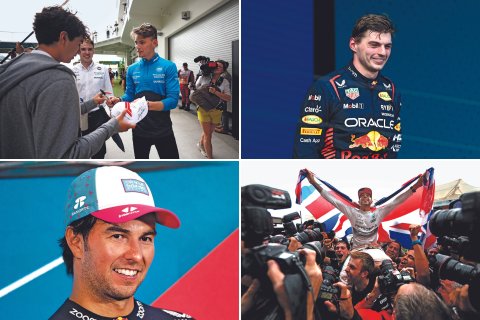
Domenicali admitted there are financial "barriers to entry" to the sport but said: "The majority of the F1 drivers that are today in the championship are coming from a very normal base." The mechanic father of French driver Esteban Ocon, who races for Alpine, for example, sold his business and family home to fund his son's karting career. The family lived in a motorhome, driving from race to race when Ocon was starting out.
However you cut it, a lot of money is needed to get to Formula 1. In 2015, Mercedes team boss Toto Wolff told business magazine Raconteur: "If somebody is very talented, you probably need to spend 1 million euros (around $1.1 million) in karting through junior, senior and international races." Then comes Formula 4, 3 and 2. Wolff continued: "You are on the verge of getting into Formula 1, but you are not in there, you need another 2-3 million euros to get the drive. So, you are talking about 7-8 million euros ... let's call it 8 million ($8.8 million)."
Parental backing played its part in Fort Lauderdale-born Sargeant's success. He was born into a wealthy family that made its money from shipping. After tearing up the karting tracks of Florida as a youngster, he moved at age 12 with his older brother Dalton and their dad, Daniel, to the U.K. to pursue his Formula 1 dream. Last year, Sargeant—who is now based in London but has "still got that American accent, that's never going anywhere"—became the first American to win a Formula 2 race and was invited to take a seat with Williams Racing in Formula 1 for the 2023 season.
"I owe [my parents] a lot, for sure," Sargeant admitted. "Their support has been massive."
The rookie driver has had a rough season so far, failing to finish higher than 12th before Monaco and coming in dead last in Miami. Sargeant picked up damage to the front wing of his car that required him to take an extra-long pitstop to replace it on the second lap of the race, putting him out of contention early. Still, the Floridian reckons his fighting nature will help him persevere.
"I think competitiveness is an extremely important trait to have," he said. "That is what drives me to keep getting better, day after day. I love the adrenaline.
"It's very early days. I'm still trying to build myself as an F1 driver, which is a challenge. That's where I'm looking at the moment, taking it day by day, trying to be better each and every time I get in the car.
"I feel like I'm one of the most competitive people in the world. I absolutely hate losing. And I feel like, also, having an older brother, that helped drive me. You know, trying to be better than the older brother, which is never an easy challenge."
Dalton Sargeant, 25, went on to compete in the NASCAR Craftsman Truck Series. Was NASCAR ever a consideration for Logan Sargeant when he was racing through the junior development ranks?
"The goal as a kid was always to make Formula 1," he said. "We know how difficult it's going to be, so you keep your mind open to other opportunities. But when I moved to Europe, that was the direction we were heading, and we did everything in our power to get to this point."
'That Drama Between the Drivers...That's What Gets You to Watch'
At a packed street circuit that surrounds the Hard Rock Stadium in Miami, it is easy to see the attraction. Billionaires Jeff Bezos and Elon Musk, along with actor Tom Cruise and Kansas City Chiefs quarterback Patrick Mahomes, were among the 270,000 race fans (30,000 more than the inaugural race last year) who flocked to catch a glimpse of the incredible men and their racing machines.
Much of the hype around Formula 1 in the U.S. is due to the success of Drive to Survive, the Netflix series that gives a behind-the-scenes look at the traveling F1 circus. Nielsen data revealed the show had nearly 570,000 viewers over the fifth season's first week in February—a 40 percent leap over 2022's season 4 debut and the most yet for the program. According to Statista, there were 49.2 million F1 fans in America in 2022, up from 44.9 million in 2019. A March 2022 poll by Morning Consult of nearly 1,900 self-identified adult U.S. Formula 1 fans showed 53 percent said Drive to Survive was the reason they started watching F1 races.
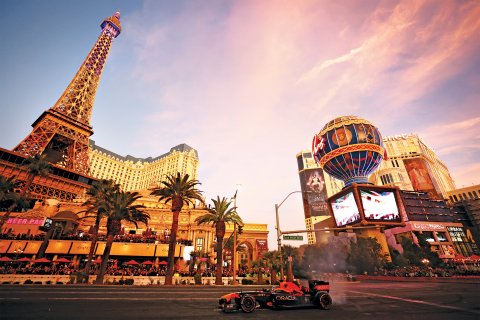
"That particular series does something for F1 that any motor sports series needs and that's to bring out the personalities in the drivers. Because when you get people interested when they're young, that makes for lifelong fans," says Brett Boyle, associate professor of marketing at Saint Louis University's Richard A. Chaifetz School of Business, likening the appeal to that of the highly successful Real Housewives franchise. "You know, there's [the] drama between drivers, the competitiveness, the backstories...that's what gets you to watch because otherwise you're just watching cars go very fast."
These new U.S. fans drawn in by the show are just the type F1 is after, too: young and affluent. Some 46 percent are younger than 34, according to Nielsen, while 69 percent earn more than $100,000 a year. Worldwide, F1's fans are one of professional sports' youngest, with an average age of 32, a survey commissioned by Motorsport Network in partnership with F1 and Nielsen Sports found.
But name recognition is still an issue for many drivers in the U.S.; only Hamilton has managed to install himself as a semi-regular on the late-night talk show circuit. Williams Racing has made a big publicity push with Sargeant, who rang the closing bell at NASDAQ in April, but it was Mexico's Sergio Perez who got the biggest cheers at the Miami Grand Prix from the large contingent of Hispanic fans in the crowd. Even Australian racer Daniel Ricciardo, who doesn't have a drive this season, is trying to keep his name in the spotlight, turning up at the Met Ball, which Hamilton previously attended.
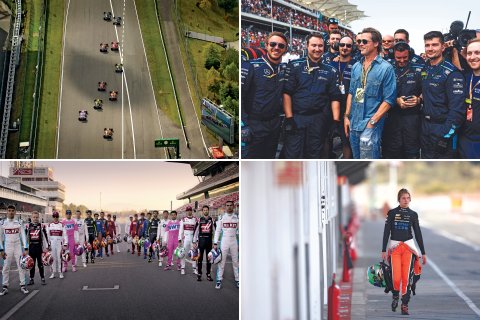
"When the marginal fans say, 'I recognize that person as an F1 driver,' that's a telling tale that you know you've made it," says Boyle, who is also executive director of SportMetric Research. "Somebody that's not a motor sports fan is going to be introduced to the sport through recognizing a driver rather than the event itself."
He adds: "One of the challenges F1 has is the lack of American drivers. That's not a detriment necessarily with young people, because I think they look beyond nationalities.... But for the longevity of F1, it's important they develop American drivers."
It's a point Domenicali takes issue with. He said: "It's important to focus on the quality of the drivers, not only the passport. [The way the driver system] is built up is giving the right possibility for everyone who wants to grow.
"Of course, there is the attention on teams to make sure that drivers are developed. It's very important and there is no doubt that if there is a great American driver, this would be another great boost for the American market. So, let's hope that Logan Sargeant will be the first to push for younger ones to be interested in Formula 1."
The popularity of the sport has not just seen the championship expand in the U.S. but further extend its reach around the world, growing from 17 races in 2020 to 22 this season (it would have been 24, if the Emilia-Romagna and the Chinese Grand Prix had not been canceled due to flooding and COVID-19, respectively). Some have speculated this number would jump to 30 by the end of the decade but Domenicali shoots that down.

"There are more places that [would] like to host Formula 1," he said. "[But] we need to be balanced in our projects, so we're gonna stay with 24. That's a credible number."
While it has been rumored that some older races in Europe may be pushed off the calendar to make way for new circuits, it doesn't look like the U.S. will be getting any more than Miami, Austin for the United States Grand Prix in October and the return of the Las Vegas Grand Prix in November, for now. "For the moment to have three races in the US...I think it is the right balance," Domenicali said. "I'm really happy to be here in Miami, really happy to go back to Austin and really excited to be in Vegas."
On F1 moving to new venues, he added: "I think this depends on how a promoter or country wants to present it to us. The right thing is to make sure that every grand prix has its own different personality. Our goal is to make sure that there is the right mix."
Ever the salesman, he is trying to find new ways to promote the sport he loves and is looking forward to having Hollywood put Formula 1 on the big screen, with Brad Pitt donning a driver's helmet. To ensure the action is as real as possible, Top Gun: Maverick director Joseph Kosinski and producer Jerry Bruckheimer, who are leading the untitled project with Hamilton co-producing, will be filming during the British Grand Prix race weekend in July. In the movie, backed by Apple Original Films with an estimated $140 million budget, a Formula 1 racer comes out of retirement to mentor a younger driver.
"We know that we need to capture the attention of different groups of people. The movie shows how progressive we are in trying to make sure we present our product on every single platform," Domenicali said. "We are involved with them. It's a huge project because we start the shooting in Silverstone [home of the British Grand Prix], something that has never happened before."
Like always, it seems, Domenicali is trying to find new ways to get fans excited about, as Boyle calls it, "watching cars go very fast."
Domenicali signed off by saying: "I just want to make sure that everyone is curious about Formula 1. Get connected with us, try to push us to answer your questions, be positive coming to see us and try to capture the intensity of our sport that is unique. It is unique to see our fans all together cheering for the different teams, different drivers, but sharing the same passion without any negativity. That's really what we want to do."




